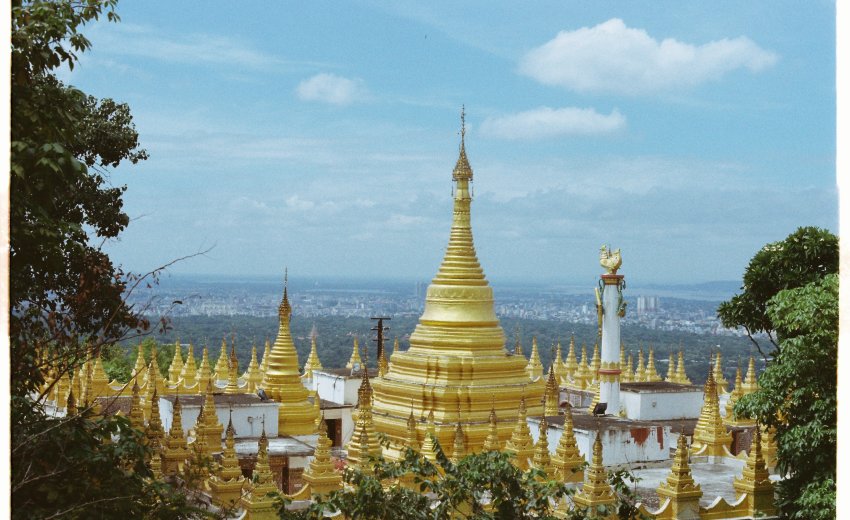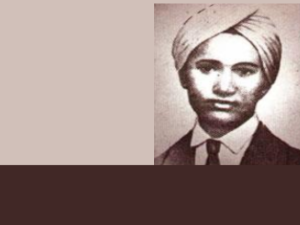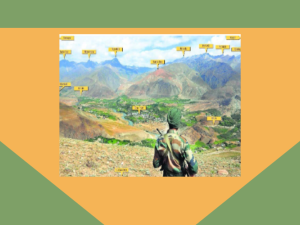Dr. Randhir Singh was born in 1885 in Gujjarwal Village (Pati Bija), Ludhiana District. His father's name was Sardar Deva Singh who was allotted 1000 acres of land land in Budhampura, Hisar district. He was also the revenue collector (Numberdar) of the village. Randhir Singh did his MBBS from Medical College, Lahore. While studying in Lahore, he came into contact with Bhai Randhir Singh, who made a big impression on him. After MBBS, he joined Burma's private health sector and was assigned to General Hospital in Rangoon, then Burma's capital. In 1941 AD, when he completed his five-year service at the age of thirty-five, he could not have served more than his five years in one place, as per government orders. He was however, given one-year extension. a first in the state. After completing his tenure in Rangoon, he was offered a position of a civil surgeon, but he declined because he set up his own hospital which could accommodate 1,000 patients.and started practice in this hospital.
His hospital always welcomed anyone with any problem. This hospital was affiliated with Rangoon Medical College. Dr. Sahib also lectured at medical colleges. He was appointed Director of Burmese Health Department and Medical Services. He was honoured with the title of Sardar Bahadur for his profession and service to the country, and was alloted 125 acres (5 mulabha) of land in Sindh Province. Power connections were also made available inexpensively by the Government of India. After serving for 34 years as Director he turned to the social welfare. He continued to donate to all medical institutions and treat patients at very low fees, sometimes even free.
In 1908, he founded the Youth Association in Rangoon and became the association's founder president. Under the aegis of this association, he founded Khalsa School in Rangoon in 1910 and donated Rs 100,000 rupees out of his own pocket for the school building. He was elected President of the school. Many students achieved very high positions after graduating from this school. He also built a Gurdwara which turned out to be the largest gurdwara in northern India. He served as the secretary of this gurdwara during his 20 years stay and brought many changes to the gurdwara and its system, resulting in a great development to the gurdwara. The gurdwaras were originally under the control of army officers who influenced the functioning of the gurdwaras as directed by the government. He transferred his control to Sangat and was able to eliminate government influence. This was opposed by both the military and the government, but he went through the opposition and included Sangat in all his decisions.
In addition to medicine, education and religion became special areas of his social service. Rangoon is a cosmopolitan city and needed a school of cosmopolitan character where the vast Indian community and wards from other communities could be educated. In light of this, he pioneered the creation of the Sharda Southern Girls' High School and served as Vice President of the school which accepted students from all communities. He also founded Khalsa Diwan Burma and served its president in Rangoon. He also founded the Punjabi Club in Rangoon and served as its founder chairman for many years. In addition, he played a leading role in establishing the Rangoon State Medical College, where he served as Vice-President.
During the Akali Movement for Freedom in Punjab's Gurdwaras, he presented a Sikh perspective to the Governor of Singapore. However, this was not appreciated by the British rulers. He also brought large numbers of Sikhs and Punjabis to Burma and got yhem the jobs. He also enrolled many students in Burmese and British universities for higher education. He was a recognized Sikh leader in Burma. Because of his social service and his kind demeanor towards the masses, even different ethnic groups were attracted towards him and called him 'Santa Claus' and 'Holy Papa'. Whenever social and religious groups from Punjab came to collect donations, he not only gave money out of his own pocket but also used it to help raise funds from others. He was very frank. Whatever he wanted to say, he said it openly and outright. He had worked in Burma's public health sector for 34 years. His stay was very noble and memorable, as noted in state records. His services were justly commended. He also performed many community services and was awarded a Certificate of Honor (Thor) and M.B.E. In July 1941 he was awarded the Coronation Order for his long and distinguished service. His name was also Mentioned in Despatches by the Governor of Burma. When the Japanese attacked Burma, he left the country and returned to India. When he left Burma, he left behind 600 acres of land, many houses, cars, and many belongings.
While in Punjab, he lived in Ludhiana and continued his social work. He collected funds and support from his friends for the creation of new educational institutions. He established many educational institution in Ludhiana, Punjab. (a) He received approval to upgrade Khalsa Girls' High School, Civil Lines, Ludhiana from middle school to high school. He also raised funds for construction and paying teachers. (b) He also founded the Malwa Khalsa School, Ludhiana. Both schools were under the aegis of Khalsa Diwan of Ludhiana. He served as honorary prsident of both schools for many years. He also paid his 500 rupees each to the school in 1910 AD. (c) He took the initiative in establishing the Shapur Boys and Girls High School in Ludhiana. He served as the school's vice-president for many years, raising funds for the construction of the building and the operation of the school. He wandered around and struggled to get the approval of all these schools. He ensured that enrollment in these schools increases regularly and that these schools are regularly upgraded to accommodate new enrollments. As a result of his efforts, the strength of his three schools increased to 1,000 students each. At the time, he held administrative positions for many years, providing free medical services to students and staff at three schools.
(d) When the Punjab state was partitioned in 1947, he was appointed Chairman of the Ludhiana Town Rehabilitation Commission for over a year. He settled about 2,00,000 refugees and provided them with food, clothing and shelter. To that end, DC Mr. Sehgal ICS and his ADM Mr. Ahuja greatly helped him complete this rehabilitation. (e) In 1948, he went to great lengths to obtain approval for the Pothhar Sayyad Khalsa School and ensured that the school also had a strength of about 1,000 pupils. The school became very famous for its excellent grades. He was the vice president of this school for many years. (f) At that time, the Punjab Government Agricultural College was to be relocated from Layalpur. The people of Amritsar tried to get it there, but with much pressure, he got it to Ludhiana (g). Another institution he worked hard on was the establishment of the Guru Nanak Dev Engg College in Ludhiana. From 1943 AD, he did paperwork and visited Sardar Sunder Singh Majithia, Minister of Defence Sardar Baldev Singh, and members of the Nankana Sahib Educational Trust. This was before the partition of Punjab. He traveled to Lyalpur, Gujranwala and Lahore to learn how engineering institutions worked. Finally Guru Nanak Dev Engineering College was established in Ludhiana in 1955 AD when the Indian President laid its foundation stone. (h) His next adventure was the founding and approval of the Malwa Training College for Women in 1957. He got its four units endorsed by Vice Chancellor Diwan Anand Kumar of Punjab University. He visited Delhi for the for the hostel building and swimming pool antd got these approved and released from he central government exchequere, (j) Later Gujranwala Guru Nanak Khalsa College was also established in Ludhiana with his continuous efforts and he managed to get 850 students enrolled in its first year which was a great feat. He remained an honorary medical officer to all these institutions.
After returning from Burma, Dr. Randhir Singh became the first settler of Model Glam Ludhiana. Over a time, about 500 to 600 families built their homes in the area. (k) He founded the Model Gram Residents Association (Registered) and served as its President for many years. He later met Deputy Minister of Railways Shanawaz and received approval for the Modelgram station. Minister Shanawaz personally laid the foundation stone of the new station. (l) Dr. Sahib was also very interested in having a convent/public school in Ludhiana. He wanted it through Khalsa Divan. He got signature of the 75% Divan's members for its approvl. However, the President and some less educated members refused to sign. As a result, he was unable to get the Khalsa Public School through Khalsa Diwan at Ludhiana on the convent lines. He also contacted the management of Gujjar Khan Khalsa High School Ludhiana, but the organizers did not agree. He then approached Chief Minister Pratap Singh, but continued opposition from the Prrsident Khalsa Divan and management of Gujranwala Khalsa High School the Khalsa Public/Convent School plan was thwarted.
Then he met Kartar Singh Mangat Forest Conservator. He was very helpful and agreed to donate Rs. 6 lakh to the project but on the condition that 10 lakhs were to be arranged from the public for the school. He tried to collect Rs 10 lakh rupees but was able to collect only 50 thousand rupees. He had to abandon this plan as well. He then travelled to Dehradun, Mussoorie, Shimla and Chandigarh to get the support he needed to open a convent school in Ludhiana, but in vain. However in 1965 Eisa das, who became Deputy Commissioner of Ludhiana, stood by him.. He w
explained his proposal to the DC, who agreed to help, and soon the Sacred Heart Convent School opened in Ludhiana. Professor Sudarshan from the University of Agriculture also helped them in this case. In July 1965 the school opened in a rented house. This was after the prospective student's ward assured her of Rs 2 million grant as desired by the DC. With 1700 applications for the first session itself, only 200 students could be admitted due to the existing capacity of the new school. Gradually, this school got to purchase 10 acres of land in Srabhanagar and it spent 2 million rupees for the new building. The funds were managed fro student fees and and parental donations. The school moved to a new building in 1968 and was turned into a 10+2 co-ed school. Dr. Sahib was an active member of the school management committee and had volunteered in the field of administration as well as free medical adi to the students.
His interest in education is well known and he was a permanent member of Khalsa Divan Sri Amritsar, President of Khalsa Diwan Ludhiana and Lifetime Fellow of All India Sikh Education Conference, Amritsar. His name was widely acknowledge among the Sikh world, and he was honored not only in India and Burma (now Myanmar) but also globally. Dr. Sahib had not only provided free medical services to students and teachers, but also to those in need. He also made frequent donations to education and other social causes, donating hundreds of thousands of rupees. He also donated enough money for the construction of Ramdas Sarai in Harmandar Sahib, Amritsar.
He maintained his health very well. He slept well, ate well and took long walks every day. He was very happy and always spoke sweet. His wife Sardaruni Daleep Kaur was the President of the Istri Sewa Society and assisted Dr. Sahib in all social work. She was at the forefront whenever she was needed. She too was a member of the Khalsa Dewan and Grewal Association. She was also known as "Madame Dale" in Rangoon for heer great social service among the society. She had great faith in Sikhism. Every year she organised Akhand Path in her home and also visited Gurudwara regularly. She performed all religious functions. Dr. Sahib had three brothers. Sardar Thakur Singh was a police inspector. Bharat Singh was Engineer in PWD and Dr. Rajender Singh was an MD who had Fellowship in Medical and Surgery and Bar-at-Law. He was a civil surgeon in Rangoon and after his retirement opened a nursing home. At Epo, he practiced medicine and was a consulting physician in a large hospital. He continued to chair the Burma All India Medical Conference. He was an excellent writer, writing articles on medical and general topics for various newspapers and magazines. Like his brother, he was also very active in social work. He too was awarded the title of Sardar Sahib and Civil M.B.E. like his brother.
Reference:
Ajaib Singh Grewal, Brief History of Grewals, Tract No. 3, Grewal Itihas Committee, June 1967, pp.35-45






